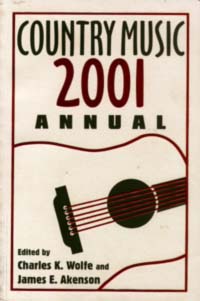



|
 |
|
The way we see country music, and the kinds of country music we listen to, are changing, and editors Charles K. Wolfe and James E. Akenson are prepared to change with them. The Country Music Annual 2001 reexamines what country music is and how is should be studied. The second volume of the Country Music Annual provides cultural scholars and fans alike with thoughtful discussions about the musical genre that has taken its place as a fixture in American popular culture. With its roots planted firmly in folk traditions, country music has grown into a variety of intriguing sub-genres. It is, the editors propose, more than a musical style; it is a business, a mythology, a history, a life style, and an art. It crosses ethnic, geographic, and economic lines. It is even blurring the line between "country" and "popular" music. Country music is a uniquely American art form and it grows in both audience and variety each year. The second volume of the Annual views country music in broad terms, as a group of musical styles that share common historical, cultural, and demographic roots. "Country music has always been surprisingly diverse," Akenson believes, "despite the apparent simplicity suggested by concepts such as `classic country."' The Annual's ten essays cover topics ranging from a study of one of the first musicians to make country records to the new wave of alternative country bands. Included in this broad spectrum of topics are discussions of the gospel music group Jerry and Tammy Sullivan, and new research on a forgotten figure in bluegrass history, Sally Ann Forrester. Also included in this second volume are two surveys that explore the connection between country music and two other cultural forces-cable television and the NASCAR racing phenomenon. Akenson says, "Country music scholarship, like country music, continues to evolve and provides new insights into its complex history as well as its complex dynamics .... Writing about country music research keeps the researcher and the reader in a constant state of growth which broadens and deepens the understanding of the country music phenomenon." The subjects of this second volume range from one of the very first musicisans to make country records, Henry Gilliland, to the current avant-garde work of the alternative country band Uncle Tupelo. Ernest Tubb's musical roots, the origins of one of Roy Acuff's classic gospel songs, and the Carter Family's rhtyms are discussed in these pages. Other chapters look at the relationship between country music and two major cultural forces of our time—cable television and NASCAR. Table of Contents
James E. Akenson, professor of curriculum and instruction at Tennessee Technological University, is founder of the International Country Music Conference. Charles K. Wolfe, professor of English and folklore at Middle Tennessee State University, is the author of numerous books, including A Good-Natured Riot: The Birth of the Grand Ole Opry. |
Hillbilly-Music.com
Yes, Hillbilly Music. You may perhaps wonder why. You may even snicker. But trust us, soon your feet will start tappin' and before you know it, you'll be comin' back for more...Hillbilly Music.
Hillbilly-music.com ...
It's about the people, the music, the history.
|
Copyright © 2000—2023 Hillbilly-Music.com
|
||||